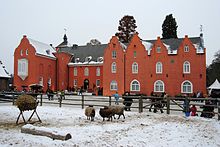Bloemersheim Castle
Bloemersheim Castle (pronunciation: Blo: mersheim) is a moated castle near Neukirchen-Vluyn , one of the most impressive complexes in the Wesel district . Nearby is Leyenburg Castle .
The facility, which dates from the late Middle Ages, was acquired by Friedrich Heinrich von der Leyen , silk producer from Krefeld , from Friedrich August von Pelden (known as Cloudt) in 1802 . It is still the headquarters of the Barons von der Leyen and the seat of an estate administration (with economically important fruit sales and forestry operations).
The castle (castle courtyard and castle garden) is only accessible for rare cultural events, but the rear side of the castle pond can be viewed from a popular bike path.
history
Documented an estate was Blomertshof 1406 as a fief of House Gastendonk led for the first time. At that time, the owners until 1510 were the Lords von Baldrich . Members of this house were judges and bailiffs in Gelderland, as the castle grounds partially belonged to the Duchy of Geldern. Around 1560, through the marriage of the heiress from the von Baldrich family, the property came to the Lords of Hoennepel called von der Impel and remained in the possession of this family for over 150 years. In 1667 the castle complex was given as a fief to the then Droste of the County of Moers, Baron von Pelden, known as Cloudt, as he had married the heir to the von der Impel family. The headquarters of the von Pelden family were Lauersfort Castle and the Impel House in Moers. Bloemersheim was mainly used as a hunting lodge.
It is not known exactly when the first original moated castle with a front building and subsequent main castle, which was originally only accessible via 2 drawbridges, was built. The border between the Duchy of Geldern and the County of Moers ran right through the castle grounds and the kitchen in the main building. It was not until the Prussians in 1724 that the border was changed so that the entire area then belonged to the Principality of Moers.
The castle was also a refuge, to which farmers living in the vicinity fled during times of war. She was attacked more often and badly damaged. For example, the first Cloudt had to have the destroyed outer bailey rebuilt. During this construction phase, the moats between the outer and main castle were filled and leveled. The family also included Reinhard von Pelden called Cloudt (1702–1770), District President of the Principality of Moers . Towards the end of the 18th century around 1790 the castle was plundered and devastated by the French. The impoverished last heirs of the Cloudt family were unable to renovate or maintain the property and it fell into disrepair.
In 1802 the Cloudts sold the entire property for 17,000 thalers to the silk baron and Krefeld mayor Friedrich Heinrich von der Leyen . In 1816 he was raised to the rank of Prussian baron von der Leyen zu Bloemersheim . The family expanded the castle and the associated park into the current palace complex. As the owner of the manor , the family was a founding member of the Rhenish knighthood in 1837 . In 1992, the agricultural and fruit growing company Schloss Dyck / Nikolauskloster was leased. Today the farms are managed by Friedrich Freiherr von der Leyen zu Bloemersheim.
Web links
Individual evidence
- ↑ Peter Caulmanns, in: Neukirchen-Vluyn his story from the beginnings to the present , Verlag Schiffer, Rheinberg, 1968, pp. 42 + 44.
- ↑ Peter Caulmanns, in: Neukirchen-Vluyn his story from the beginnings to the present , Verlag Schiffer, Rheinberg, 1968, pp. 42 + 43.
- ↑ Peter Caulmanns, in: Neukirchen-Vluyn his story from the beginnings to the present , Verlag Schiffer, Rheinberg, 1968, pp. 43 + 44.
Coordinates: 51 ° 26 ′ 33.1 ″ N , 6 ° 30 ′ 53.5 ″ E


